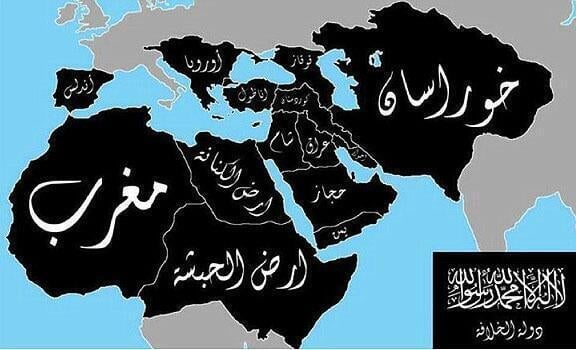Don’t believe the people telling you to freak out over this “ISIL” map
This map has been floating around Twitter recently, but it’s been on the internet for months at least. Now that the Islamic State in Iraq and the Levant (ISIL)—or as it now prefers to call itself, just the Islamic State—has had military success in Iraq, the graphic has become a viral sensation and a media touchstone, because, according to ABC News, it is ”a map showing their plans for the next five years.”


This map has been floating around Twitter recently, but it’s been on the internet for months at least. Now that the Islamic State in Iraq and the Levant (ISIL)—or as it now prefers to call itself, just the Islamic State—has had military success in Iraq, the graphic has become a viral sensation and a media touchstone, because, according to ABC News, it is ”a map showing their plans for the next five years.”

It is, in fact, not.
“It’s an old image put out by fans of the group,” says Aaron Zelin, a fellow at the Washington Institute for Near East Policy who also maintains a blog, Jihadology.net, that analyzes primary source material produced by Islamist movements. “There is nothing official about it nor is there some alleged 5-year plan.”
While ISIL obviously does have plans to control territory and impose its extreme take on Islamist politics, this particular map is just an ahistorical mash-up of past Muslim political entities. They range from the empire that emerged from modern-day Saudi Arabia in the 7th century to the Ottoman Empire, with its roots in Turkey, that collapsed in 1923. (The Daily Mail has a rough English-language version of the map.)
It is also an ironic creation, considering that many of the polities whose territory is encompassed by this map endorsed brands of Islam and politics that would offend ISIL. To over-simplify, ISIL’s ideology comes from the branch of modern Islam that seeks a purifying return to the early days of Islam, rejecting later “innovations” in the religion that, they believe, corrupt its original spirit.
But historically, many of these innovations arose in response to Islam’s political needs in ruling an expanding empire. As early Muslim leaders dealt with internal divisions and absorbed territories with non-Muslim populations, Islam developed a canon of religious law, new varieties—Shi’a Islam and Sufi mysticism, both abhorred by ISIL—and ways to co-exist with Christians and Jews. That legacy has led organizations like ISIL and Al Qaeda to condemn the later Caliphates and the Ottoman Empire for diverging too much from what they see as pure Islam—hence their desire to start over.
But it can be hard to start over without changing. Much has been made of how ISIL is trying to learn from previous Islamist groups in Iraq, whose indiscriminate violence alienated even their co-religionists and led local Sunni Muslims to work with American troops to subdue the Iraqi insurgency in 2007 and 2008. But considering their penchant for mass executions, its not clear they’ve innovated enough to prevent another self-destructive backlash.